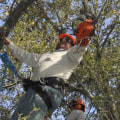Over-pruning is a common mistake that can weaken a tree, disrupt its natural growth patterns, and leave it vulnerable to disease, pests, and environmental stress. While trees have a remarkable ability to heal and adapt, recovery from excessive pruning depends on several factors, including the tree species, the extent of the damage, and the care provided after the pruning mistake. When too many branches are removed, a tree loses a significant portion of its foliage, which is essential for photosynthesis and energy production. This can lead to a decline in health, making it more susceptible to infections and structural instability. However, with proper care and patience, a tree can often recover and regain its strength over time.
The Effects of Over-Pruning on Tree Health
When a tree is over-pruned, it struggles to produce enough energy to sustain itself. Leaves play a crucial role in absorbing sunlight and converting it into nutrients, so removing too many branches at once can send the tree into a state of shock. Some trees respond by producing an excessive number of weak, fast-growing shoots called water sprouts. These shoots grow rapidly but do not contribute to the overall health or stability of the tree. Instead, they make the tree more vulnerable to storm damage and pest infestations. Additionally, large open wounds from aggressive pruning expose the tree to decay and disease, as fungi and bacteria can easily enter through cut surfaces.
Steps to Help a Tree Recover from Over-Pruning
While an over-pruned tree cannot immediately restore lost branches, there are several ways to support its recovery. The first step is to avoid further stress by refraining from additional pruning until the tree has had time to heal. Providing adequate water, especially during dry periods, ensures that the tree has the resources it needs to grow new leaves and branches. Mulching around the base of the tree helps retain moisture and protect the roots, while proper fertilization provides essential nutrients for recovery. Additionally, monitoring for signs of disease or pest infestations is crucial, as weakened trees are more susceptible to problems that could further hinder their ability to heal.
The Role of Time and Patience in Tree Recovery
Tree recovery from over-pruning does not happen overnight. Depending on the species and the severity of the pruning, it may take several growing seasons for the tree to regain its full canopy. Slow-growing trees may require years to replace lost foliage, while fast-growing species can recover more quickly. Encouraging healthy regrowth involves maintaining proper tree care practices, such as watering during droughts, avoiding mechanical damage to the trunk and roots, and allowing the tree to regrow naturally without additional intervention. In some cases, strategic pruning of water sprouts may be necessary to guide the tree toward a healthier structure.
When to Seek Professional Help
If a tree has been severely over-pruned and shows signs of decline, consulting a certified arborist is recommended. An experienced tree care professional can assess the damage, provide guidance on corrective pruning techniques, and recommend treatments to enhance the tree’s recovery. In some cases, structural support, such as cabling or bracing, may be necessary to prevent limb failure. Arborists can also advise homeowners on the best course of action if the tree’s health continues to deteriorate despite efforts to support its recovery.
Preventing Over-Pruning in the Future
To avoid over-pruning, it is essential to follow proper pruning techniques and understand the growth habits of different tree species. Regular, moderate pruning that removes dead or diseased branches while maintaining the natural structure of the tree is the best approach. Homeowners should also be cautious when hiring tree care services, ensuring that professionals use industry-approved practices rather than excessive cutting. Over-pruning not only affects tree health but can also lead to property damage if weakened limbs become hazardous during storms.
The Long-Term Impact of Over-Pruning on Trees and Property
Over-pruned trees are not just a concern for aesthetics but also for property safety. Weakened trees with poor structural integrity can pose a risk to homes, vehicles, and outdoor spaces, especially during storms or high winds. Property owners should regularly inspect trees for signs of stress and consider working with professionals like All County Roofing if nearby trees pose a threat to roofs or other structures. Maintaining healthy, well-pruned trees ensures a safe and beautiful landscape while preventing costly damage caused by improperly managed growth.
Final Thoughts on Tree Recovery from Over-Pruning
While over-pruning can be detrimental to tree health, many trees can recover with proper care and time. Supporting tree recovery involves providing adequate water, nutrients, and protection while allowing the tree to heal naturally. Preventing excessive pruning in the future and working with knowledgeable tree care professionals can help maintain strong, healthy trees that enhance the landscape and provide environmental benefits. By understanding how trees respond to pruning and taking a proactive approach to tree care, homeowners and property managers can ensure the long-term health and safety of their green spaces.






